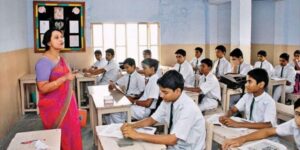Unraveling the Complexities: Issues Plaguing the Education Sector in India
Relevant for UPSC Mains GS 2 – Social Justice

Introduction
India, the world’s largest democracy, is poised for growth and development across multiple sectors, with education playing a crucial role in shaping the nation’s future. However, the Indian education system faces several challenges that hinder its progress and prevent it from realizing its full potential. In this comprehensive blog, we delve into the various issues related to the education sector in India, discussing their root causes, consequences, and potential solutions.
Access to Education: One of the primary challenges in the Indian education system is ensuring access to education for every child, regardless of their socio-economic background. Despite the Right to Education (RTE) Act making education a fundamental right, many children still lack access to quality schooling, especially in rural and remote areas.
Possible Solutions:
- Strengthening infrastructure: Improving school facilities, providing adequate transportation, and ensuring access to basic amenities like clean drinking water and sanitation can make schools more accessible.
- Community-based initiatives: Involving local communities in the development and management of schools can help ensure that the needs of the community are met, making education more accessible to all.
Quality of Education: The quality of education in India varies significantly across schools, with many students not acquiring the necessary foundational skills in reading, writing, and arithmetic.
Possible Solutions:
- Teacher training and development: Providing adequate training and professional development opportunities for teachers can help improve the quality of education.
- Curriculum reform: Updating the curriculum to make it more relevant, engaging, and student-centric can enhance learning outcomes.
- Emphasis on skill development: Integrating vocational and life skills into the curriculum can ensure that students are better prepared for the future.
High Dropout Rates: India faces a high dropout rate in both primary and secondary education, with many children leaving school due to various factors, including poverty, child labor, early marriage, and inadequate infrastructure.
Possible Solutions:
- Addressing socio-economic issues: Implementing policies and programs that tackle poverty, child labor, and early marriage can help reduce dropout rates.
- Retention initiatives: Introducing scholarships, mid-day meal schemes, and other incentives can encourage students to continue their education.
Teacher Shortages and Inadequate Teacher Training: India grapples with a severe shortage of qualified and trained teachers, particularly in rural areas. Overburdened teachers struggle to provide individual attention to students, impacting the quality of education.
Possible Solutions:
- Recruitment initiatives: Attracting qualified individuals to the teaching profession through competitive compensation packages and other incentives can help address the shortage of teachers.
- Enhancing teacher training programs: Strengthening pre-service and in-service teacher training programs can ensure that teachers are equipped with the necessary skills and knowledge to provide quality education.
Inequality in Education: Socio-economic disparities, gender biases, and discrimination against marginalized communities often lead to unequal access to quality education.
Possible Solutions:
- Promoting inclusive education: Implementing policies and programs that promote inclusive education, such as scholarships for marginalized students, gender-sensitive curricula, and accessible infrastructure for students with disabilities, can help bridge the inequality gap.
Rote Learning and Examination System: The Indian education system often emphasizes rote learning and prioritizes examination scores over holistic development and critical thinking.
Possible Solutions:
- Examination reforms: Adopting alternative assessment methods that focus on students’ understanding and application of concepts, rather than rote memorization, can help shift the emphasis from exams to learning.
- Encouraging critical thinking: Integrating problem-solving and critical thinking exercises into the curriculum can help develop students’ analytical skills.
Financial Constraints: Limited funding for the education sector often results in inadequate infrastructure, resources, and facilities, which negatively impact the quality of education.
Possible Solutions:
- Increasing government expenditure: Allocating a higher percentage of the national budget to education can help address the financial constraints faced by the sector.
- Public-private partnerships (PPPs): Encouraging collaborations between the government and private sector can help bring in additional funding, resources, and expertise to improve the quality of education.
- Community engagement: Mobilizing local communities and involving them in the development and management of schools can help supplement government resources and ensure that schools have the necessary infrastructure and facilities.
Integration of Technology: Inadequate integration of technology in the education sector can limit students’ access to quality educational resources and impede their ability to compete in the digital age.
Possible Solutions:
- Enhancing digital infrastructure: Investing in digital infrastructure, such as high-speed internet connectivity and computer labs, can help facilitate the integration of technology in education.
- Promoting e-learning: Encouraging the adoption of e-learning platforms and digital resources can help bridge the gap between urban and rural schools and improve the quality of education for all students.
Conclusion: The challenges facing the education sector in India are multifaceted and complex, requiring a concerted effort from various stakeholders, including the government, private sector, non-governmental organizations, and local communities. By understanding and addressing these issues, India can build a more robust and inclusive education system that caters to the diverse needs of its population and lays the foundation for a brighter future. With the right strategies and interventions, the country can overcome these hurdles and ensure that every child in India receives the education they deserve, ultimately contributing to the nation’s growth and development.

